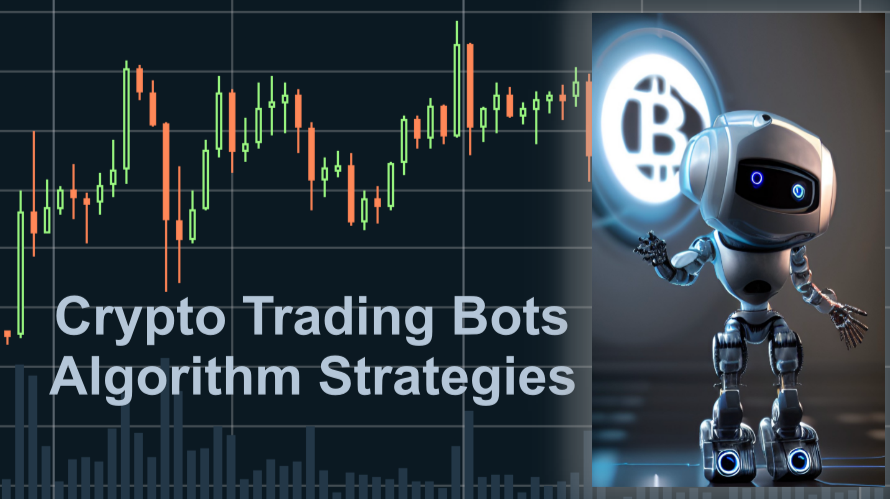Crypto Trading Bots - Algorithm Strategies

My previous article was titled Crypto Trading Bots Introduction which reviewed why one would want to use a trading bot and how to use one. In this article we will look at the brains behind the trading bots - their underlying algorithm trading strategies.
Bots are great at executing what they are programmed to do, the key is programming them with a successful trading strategy. That is easier said than done and there are a number of different strategies one can use to put their trading bots to work. Each strategy has its own strengths and weaknesses. Diversification, or the use of multiple bots each using algorithms based on different strategies, is a way to limit overall risk when using trading bots.
LIST OF TRADING BOT STRATEGIES
Trend Following
One of the most widely used and simplest trading bot strategy is trend following. Bots look at market changes spotting trends and respond accordingly. This is a good strategy for beginners as it doesn't require predictive analysis meaning the algorithms do not have to be complex. An example of trend following would be a bot that looks at the moving average, say 50 or 200-days, and is set to sell the crypto when above the average and buy when below.
Short and Long Trend Trading
This is a form of trend following that can be very effective when done correctly. Using this strategy, bots analyze pumps and dips and will go long or short on the coin accordingly. For example, if the assets dips in price the algorithm shorts the asset with an assumption the price will go down. Here you are using options and betting the price will drop and by shorting the bot can purchase the crypto later at a lower price. The difference in price, or spread, at that point determines the profit made.
Momentum Trading
This strategy assumes that strong trends tend to continue for some time. If an asset is moving higher, more buyers jump in and continue to push the asset even higher. The same principle is in play as an asset is falling when panic sets in with the sellers. In these situations the bots focus heavily on volume, time and the level of volatility to determine how strong the trend is.
Mean Reversion
This basic algorithm strategy is based on the premise that a cryptocurrency will tend to return to its average price. There are different averages one can use, however, time and volume-weighted average price are two of the most common. This strategy often works looking at a range that includes the upper or lower limits of the average price. These figures serve as signals for the bot to conduct a trade to purchase or sell crypto. This strategy is effective when no obvious trend exists such as consolidation periods within the market.
Arbitrage
Using this strategy a bot compares an asset's price on multiple exchanges and takes advantage of the difference. The old adage, buy low and sell high is the goal here and the speed at which bots execute trades makes this possible. Crypto is perfect for this strategy given the volatility and lack of a single centralized exchange which means a coin will have different prices depending on the exchange being looked at. The location of exchanges matter, for example price differences are common between exchanges in the United States and South Korea. The key here is to move quickly and not fall victim to price slippage. Volume can be another major factor putting retail traders at a disadvantage.
Scalping
This strategy isn't just used on concert and sports tickets. Trading bots use high frequency trading (HFT) to make hundreds or thousands of trades in a second if not more. Here you are attempting to make a very small profit with each trade but use heavy trading volume to make significant profits. One of the most valuable aspects of using an automated system is its ability to operate at a pace that no human can match. High-frequency trading (or scalping) is the method of using an automated system to potentially make hundreds of thousands of trades in a fraction of a second. There are a couple of different approaches one can take here but taking advantage of the difference between the bid and ask prices is a popular choice.
News Based or Natural Language Processing (NLP)
It is no secret that humans instinctively react to the news. Bots can use keywords to examine the news and make predictions on how that news will sway a particular coin or tokens price. Using AI, bots can scan news articles and/or social media to determine the market sentiment on any given cryptocurrency and set a buy or sell strategy accordingly.
Machine Learning
Bots can utilize machine learning models to beat other methods of trading. Artificial intelligence is becoming more and more mainstream, and trading bots are taking advantage of this to look at data and be able to accurately predict price action. For the most part, these strategies involve using predictive analysis to determine what direction an asset will move next. The higher the probability, the better the signal to buy or sell any given crypto and the more capital the bot will allocate to the trade using risk analysis.
Conclusion
Regardless of which strategy or set of strategies you choose to utilize with your trading bot(s), it is always a good idea to back test them first to see how they perform in a variety of market conditions. You also must determine how much capital you want to put to work and how to split that capital up for each bot being used.
Now that you have a basic understanding of some crypto trading bot algorithm strategies it is time to look at selecting an actual bot. We will tackle that in our next article.